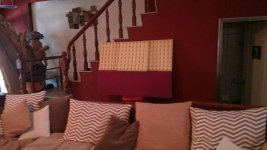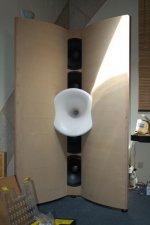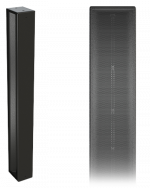The couch (partially seen) in the previous posted picture didn't give it away? 
Let's rotate trough the room (as seen in the more recent pic, the Stereo has moved)



The ambient speakers are behind the back rest of the couch. As said, the gap between the couch and poster gets filled with cushions during listening sessions and/or movies. This gives me 3 great seats of sound, one of them (the centre one) being more than great. During movies my son sits there after having experienced the benefits . Makes me glad I spend some time to get a wide sweet sounding area.
. Makes me glad I spend some time to get a wide sweet sounding area.
Let's rotate trough the room (as seen in the more recent pic, the Stereo has moved)



The ambient speakers are behind the back rest of the couch. As said, the gap between the couch and poster gets filled with cushions during listening sessions and/or movies. This gives me 3 great seats of sound, one of them (the centre one) being more than great. During movies my son sits there after having experienced the benefits
How does that lonely little TC9 holding up as centre speaker? 
that's a dwarf next to the Towers!
Here's my temporary solution to the back wall, it's portable, and so far, I didn't get huge rolling eyes from the wife... I'm sure she wants to say something, but since I can take it all away quickly (as it is not there most of the time, but only when I listen more carefully or run sweeps), she tolerates the setup... so far.
The bottom is a frame filled with RockWool 3" (9cm) thick, and some 5cm acoustic foam stacked on top.
that's a dwarf next to the Towers!
Here's my temporary solution to the back wall, it's portable, and so far, I didn't get huge rolling eyes from the wife... I'm sure she wants to say something, but since I can take it all away quickly (as it is not there most of the time, but only when I listen more carefully or run sweeps), she tolerates the setup... so far.
The bottom is a frame filled with RockWool 3" (9cm) thick, and some 5cm acoustic foam stacked on top.
Attachments
A couple of factors to keep in mind:
- the off axis output will be about the same as the single driver used in the array, meaning no controlled directivity horizontally compared to normal speakers.
- you need EQ to get things in shape. No way around that unless you go with a shaded array or other solutions.
You do get way less in-room reflection problems, mainly from floor and ceiling, the line of drivers has a way to average out those reflections. Vertical planes parallel to the arrays are the biggest source of worries.
Hope this helps to get an idea. I couldn't tell you if it would work out. I have zero experience in a room line that. I have seen more than one line solution used for spaces like that. Horns could be another solution. That way you can determine both horizontal and vertical directivity.
- the off axis output will be about the same as the single driver used in the array, meaning no controlled directivity horizontally compared to normal speakers.
- you need EQ to get things in shape. No way around that unless you go with a shaded array or other solutions.
You do get way less in-room reflection problems, mainly from floor and ceiling, the line of drivers has a way to average out those reflections. Vertical planes parallel to the arrays are the biggest source of worries.
Hope this helps to get an idea. I couldn't tell you if it would work out. I have zero experience in a room line that. I have seen more than one line solution used for spaces like that. Horns could be another solution. That way you can determine both horizontal and vertical directivity.
Has anyone in the USA heard these? The driver appears to be a magnetically shielded version of the TG9FD10.
Advantages* of the* IDS Technology
My Experience with Column Systems
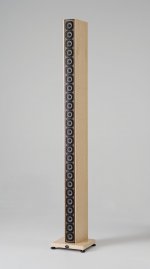
Advantages* of the* IDS Technology
My Experience with Column Systems

those have been discussed a lot.
It's one of the reason wesayso decided to build his own... not willing to spend $18,000... Although, if you ask him today, I'm sure he will say they are worth it with the amount of work put into them, either the IDS, or the Two Towers... even though, to me, the Towers look even better!
Although, if you ask him today, I'm sure he will say they are worth it with the amount of work put into them, either the IDS, or the Two Towers... even though, to me, the Towers look even better!
It's one of the reason wesayso decided to build his own... not willing to spend $18,000...
A couple of factors to keep in mind:
- the off axis output will be about the same as the single driver used in the array, meaning no controlled directivity horizontally compared to normal speakers.
- you need EQ to get things in shape. No way around that unless you go with a shaded array or other solutions.
You do get way less in-room reflection problems, mainly from floor and ceiling, the line of drivers has a way to average out those reflections. Vertical planes parallel to the arrays are the biggest source of worries.
Hope this helps to get an idea. I couldn't tell you if it would work out. I have zero experience in a room line that. I have seen more than one line solution used for spaces like that. Horns could be another solution. That way you can determine both horizontal and vertical directivity.
Thanks for the reply !
So, a medium sized line array with horn loaded drivers should work, right ?
Our Church is big, width=20, length=~120, height (parabolic profiled roof)=16.5 meters at its highest point. The biggest issue is the floor, which is granite, reflects a lot of acoustic energy. The side walls have a wooden paneling which have 2" sq mesh shape with a depth of 3" to absorb sound.
Its a beautiful Church but PA system sounds horrible. We have tried four different systems, none worked. Never tried a line array though.
There's one PA solution that might do real well, the Danley SBH series...
SBH-10 | Danley Sound Labs, Inc.
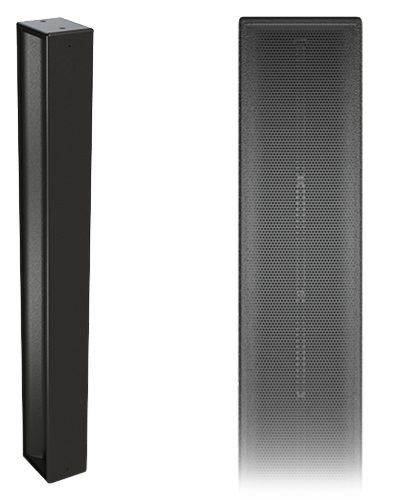
It "looks" line a line array but isn't. It would have horizontal and vertical controlled directivity.
If you want to build something I'd build a reasonably tall array (over 2 M) with wave guides at the side resembling the guides on this one:
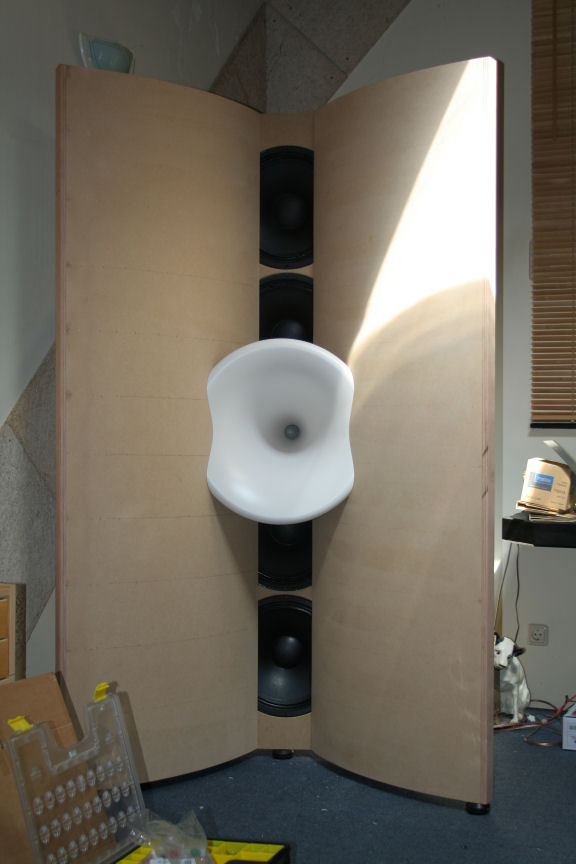
(Omitting the horn)
Use smaller drivers and lots of them. In other words, put speakers like mine at the apex of the big guides. You still need EQ and can't use (much) phase correction in live broadcasting.
SBH-10 | Danley Sound Labs, Inc.
It "looks" line a line array but isn't. It would have horizontal and vertical controlled directivity.
If you want to build something I'd build a reasonably tall array (over 2 M) with wave guides at the side resembling the guides on this one:
(Omitting the horn)
Use smaller drivers and lots of them. In other words, put speakers like mine at the apex of the big guides. You still need EQ and can't use (much) phase correction in live broadcasting.
Attachments
There's one PA solution that might do real well, the Danley SBH series...
SBH-10 | Danley Sound Labs, Inc.

It "looks" line a line array but isn't. It would have horizontal and vertical controlled directivity.
If you want to build something I'd build a reasonably tall array (over 2 M) with wave guides at the side resembling the guides on this one:

(Omitting the horn)
Use smaller drivers and lots of them. In other words, put speakers like mine at the apex of the big guides. You still need EQ and can't use (much) phase correction in live broadcasting.
Thanks man :thumbsup:
Appreciate it
Now, let me finish my other project before researching those^ guys
Thanks for the reply !
So, a medium sized line array with horn loaded drivers should work, right ?
Our Church is big, width=20, length=~120, height (parabolic profiled roof)=16.5 meters at its highest point. The biggest issue is the floor, which is granite, reflects a lot of acoustic energy. The side walls have a wooden paneling which have 2" sq mesh shape with a depth of 3" to absorb sound.
Its a beautiful Church but PA system sounds horrible. We have tried four different systems, none worked. Never tried a line array though.
Compared to horn systems line arrays have a very big advantege: they are optically far more unobtrusive.
In your case I'd certainly choose line arrays, maybe even taller than Wesayso's, think about 36 chassis per side. If toed in slightly, side walls shouldn't be much of an issue. And floor reflections would be greatly reduced, ceiling as well.
Bear in mind that such a system has to be filtered quite heavily...
Regards
Gerald
Last edited:
If you want to build something I'd build a reasonably tall array (over 2 M) with wave guides at the side resembling the guides on this one:

(Omitting the horn)
Use smaller drivers and lots of them. In other words, put speakers like mine at the apex of the big guides. You still need EQ and can't use (much) phase correction in live broadcasting.
Ouch! Now imagine this LineHorn with 36x TC9FD...
So, there needs to be some heavy eq. needed to make it sound "flat"?Compared to horn systems line arrays have a very big advantege: they are optically far more unobtrusive.
In your case I'd certainly choose line arrays, maybe even taller than Wesayso's, think about 36 chassis per side. If toed in slightly, side walls shouldn't be much of an issue. And floor reflections would be greatly reduced, ceiling as well.
Bear in mind that such a system has to be filtered quite heavily...
Regards
Gerald
So, there needs to be some heavy eq. needed to make it sound "flat"?
Yes they do.
As a matter of fact, if your church does not have an EQ system, I'd start there. You might be able to salvage your current system and speakers by adding a good EQ unit.
Any big venues, like churches, will have resonant frequencies that will need to be tamed. Get a mic (cheap these days, something like the UMIK-1 or others) and see what's happening in your church. Take a few readings around and see where there are spikes in the frequency sweeps.
Using some EQ unit to dial down those spikes will help things a lot.
To test it, without investing in a unit, measure first with a mic. then use a prerecorded material, a sermon or some conversation, and play it back via the computer, using EQ from the computer, taming those peaks you saw in the sweeps to see if it improves. If it does, you'll know where to invest, before starting buying another set of speakers, investing money blindly.
My 2 cents anyway....
We do have big a$$ eq unit and I guess there is option to add "delay" too IIRC. There are lot of sliders and knobsYes they do.
As a matter of fact, if your church does not have an EQ system, I'd start there. You might be able to salvage your current system and speakers by adding a good EQ unit.
Any big venues, like churches, will have resonant frequencies that will need to be tamed. Get a mic (cheap these days, something like the UMIK-1 or others) and see what's happening in your church. Take a few readings around and see where there are spikes in the frequency sweeps.
Using some EQ unit to dial down those spikes will help things a lot.
To test it, without investing in a unit, measure first with a mic. then use a prerecorded material, a sermon or some conversation, and play it back via the computer, using EQ from the computer, taming those peaks you saw in the sweeps to see if it improves. If it does, you'll know where to invest, before starting buying another set of speakers, investing money blindly.
My 2 cents anyway....
And yeah, the eq. has been tuned by a sound engineer for our church already but its not working for all voices !
I'm sorry for this OT talk !
May be I should create a new thread
- Home
- Loudspeakers
- Full Range
- The making of: The Two Towers (a 25 driver Full Range line array)
